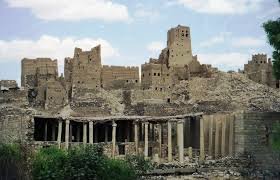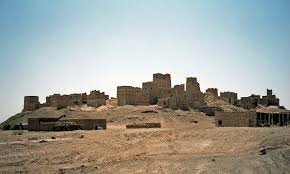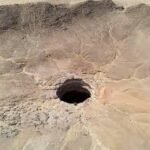Ma’rib: The Legendary City That Defied the Desert
Deep in Yemen’s arid landscapes lies Ma’rib, once the glittering capital of the Sabaean Kingdom and home to the fabled Queen of Sheba. What made this city extraordinary wasn’t just its wealth from the frankincense trade, but its ability to flourish in the desert through an engineering marvel – the Great Dam of Ma’rib. For over a millennium, this ancient metropolis thrived where no city should have survived, creating an oasis civilization that Quranic verses would later describe as “a garden on either side.” The dam’s catastrophic collapse in 570 AD didn’t just destroy infrastructure; it triggered a mass migration that changed Arabian demographics forever, scattering tribes across the peninsula and influencing the rise of Islam.
Bilqis’ Hidden Throne: The Queen of Sheba’s Real Palace
While most associate the Queen of Sheba (Bilqis in Islamic tradition) with Ethiopia, her true power base was Ma’rib. Recent excavations have revealed the remnants of her supposed palace at the Ghumdan site, featuring:
- A sun temple with an altar for the moon god Almaqah
- Hidden underground chambers possibly used for sacred rituals
- Advanced hydraulic systems that channeled water directly to royal baths
Local legends speak of Bilqis’ “flying throne” – likely a poetic description of a palanquin transported along elevated aqueducts. The Quran’s account of her visit to Solomon takes on new meaning when one stands in Ma’rib’s ruins, imagining her departure from this sophisticated city to Jerusalem’s grandeur.
Engineering Marvel of Ma’rib: The Dam That Built a Civilization
The Great Dam of Ma’rib stands as one of antiquity’s greatest engineering feats, predating the Roman aqueducts. Constructed as early as 1750 BC and continually expanded, this 580-meter structure transformed desert into farmland through:
- Sophisticated sluice gates controlling water distribution
- A 25,000-acre irrigation network feeding 50,000 people
- Sedimentation basins preventing mineral buildup
What few realize is that the dam didn’t just store water – it created an artificial microclimate. Ancient texts describe Ma’rib’s hinterland as so fertile that “a child could harvest fruit simply by reaching from one branch to another.” The dam’s final collapse was so traumatic it’s memorialized in the Quran (Saba 34:16) as divine punishment for ingratitude.
The Frankincense Fortune: How Ma’rib Controlled the World’s First Luxury Trade
Ma’rib’s wealth came from controlling the frankincense trail, where caravans transported the precious resin from Dhofar to Mediterranean markets. The city became:
- The Arabian Peninsula’s first taxation hub
- Home to the ancient world’s most sophisticated banking system (using written promissory notes)
- A melting pot of Greek, Egyptian, and Mesopotamian merchants
Recent discoveries of ship engravings in Ma’rib’s ruins suggest the Sabaeans may have secretly transported frankincense via hidden Red Sea routes when land taxes grew too high. The city’s elite lived in multi-story mansions with imported Indian teak and Persian carpets – unimaginable luxury in the ancient desert.

Sacred Inscriptions & the Moon God’s Temple
The Awam Temple (Mahram Bilqis) was the religious heart of Ma’rib, dedicated to Almaqah. Its 8-meter-high oval wall enclosed:
- An oracle chamber where priestesses interpreted dreams
- A sacred well containing thousands of bronze votive offerings
- The “Pillars of Destiny” – inscribed columns predicting the kingdom’s fate
Deciphering Sabaean inscriptions revealed shocking details – including a possible revolt against Bilqis by priests unhappy with her Solomon alliance. The most poignant discovery was a stone tablet documenting the dam’s final repairs, bearing the names of 12,000 workers who desperately tried to save their civilization.
The Collapse That Changed History
When the dam finally burst after centuries of neglect, it didn’t just destroy Ma’rib – it altered the course of Arabian history. The “Year of the Elephant” (570 AD) saw:
- 50,000 people abandoning the city within months
- Tribes migrating north to Mecca and Medina
- The Quraysh tribe (Muhammad’s ancestors) rising as new power brokers
This mass movement of skilled Sabaeans may have indirectly enabled Mecca’s later prominence. Some scholars argue the dam’s collapse created the social conditions that made Islam’s rise possible just 60 years later.
Modern Rediscovery & Dangerous Exploration
Despite being Yemen’s most important archaeological site, Ma’rib remains dangerously inaccessible due to ongoing conflicts. Recent findings by brave archaeologists include:
- A buried library of wooden tablets preserving legal codes
- The “Gate of Tears” – a massive bronze portal mentioned in ancient texts
- Underground grain silos that could feed the city during sieges
Tragically, looting has become rampant, with stolen Sabaean artifacts appearing on black markets. The site’s proximity to active conflict zones means its full secrets may remain hidden for years to come.
Ma’rib’s Legacy: From Ruins to Recognition
Today, Ma’rib stands at a crossroads between oblivion and preservation. The dam’s remnants still dominate the landscape, while the city’s:
- Moon temple’s foundations have survived 2,800 years
- Ancient street grid remains visible from satellite imagery
- Irrigation channels still influence modern Yemeni farming techniques
As Saudi Arabia funds restoration projects, there’s hope this forgotten cradle of Arabian civilization may yet reclaim its place in history. Standing among Ma’rib’s ruins at sunset, one can almost hear echoes of camel caravans and the distant prayers to Almaqah – reminders of when this desert capital stood at the center of the ancient world.
The story of Ma’rib is more than archaeology; it’s a cautionary tale about environmental management, a testament to human ingenuity, and a missing chapter in understanding Arabian heritage. As conflict eventually subsides, the world may finally appreciate how this lost city’s dams and temples laid foundations for civilizations that followed.
Go to main page


